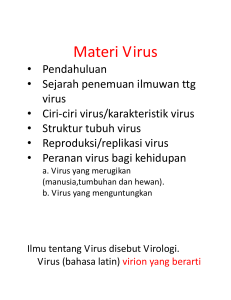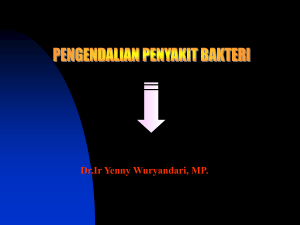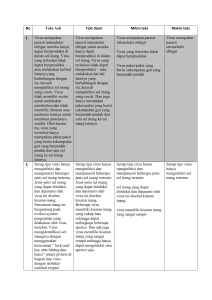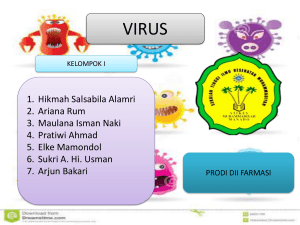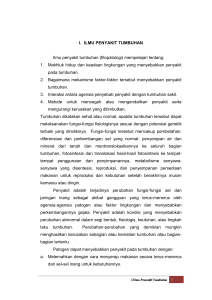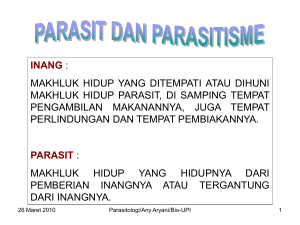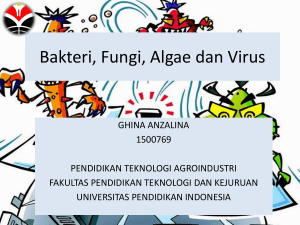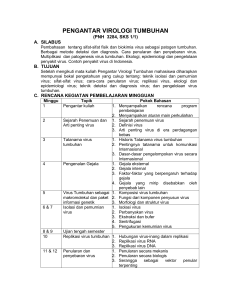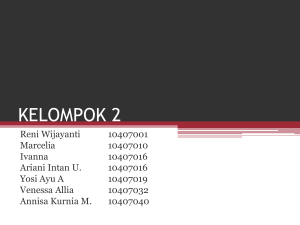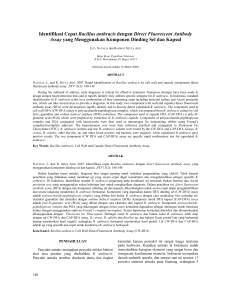Viral Pathogenesis
advertisement
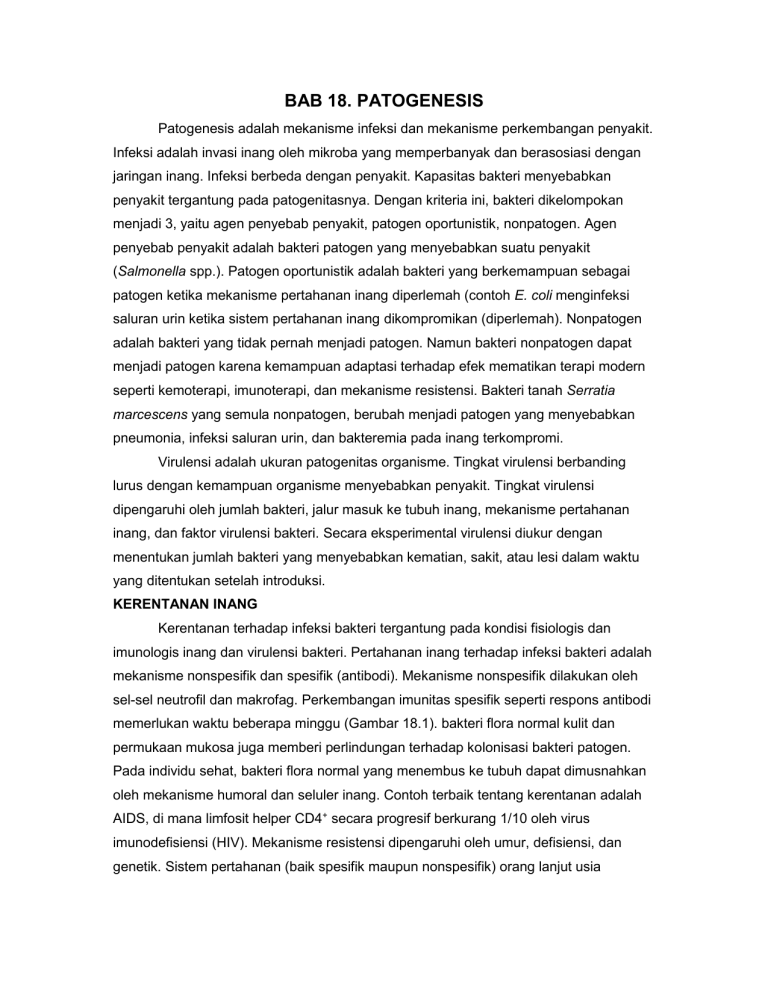
BAB 18. PATOGENESIS Patogenesis adalah mekanisme infeksi dan mekanisme perkembangan penyakit. Infeksi adalah invasi inang oleh mikroba yang memperbanyak dan berasosiasi dengan jaringan inang. Infeksi berbeda dengan penyakit. Kapasitas bakteri menyebabkan penyakit tergantung pada patogenitasnya. Dengan kriteria ini, bakteri dikelompokan menjadi 3, yaitu agen penyebab penyakit, patogen oportunistik, nonpatogen. Agen penyebab penyakit adalah bakteri patogen yang menyebabkan suatu penyakit (Salmonella spp.). Patogen oportunistik adalah bakteri yang berkemampuan sebagai patogen ketika mekanisme pertahanan inang diperlemah (contoh E. coli menginfeksi saluran urin ketika sistem pertahanan inang dikompromikan (diperlemah). Nonpatogen adalah bakteri yang tidak pernah menjadi patogen. Namun bakteri nonpatogen dapat menjadi patogen karena kemampuan adaptasi terhadap efek mematikan terapi modern seperti kemoterapi, imunoterapi, dan mekanisme resistensi. Bakteri tanah Serratia marcescens yang semula nonpatogen, berubah menjadi patogen yang menyebabkan pneumonia, infeksi saluran urin, dan bakteremia pada inang terkompromi. Virulensi adalah ukuran patogenitas organisme. Tingkat virulensi berbanding lurus dengan kemampuan organisme menyebabkan penyakit. Tingkat virulensi dipengaruhi oleh jumlah bakteri, jalur masuk ke tubuh inang, mekanisme pertahanan inang, dan faktor virulensi bakteri. Secara eksperimental virulensi diukur dengan menentukan jumlah bakteri yang menyebabkan kematian, sakit, atau lesi dalam waktu yang ditentukan setelah introduksi. KERENTANAN INANG Kerentanan terhadap infeksi bakteri tergantung pada kondisi fisiologis dan imunologis inang dan virulensi bakteri. Pertahanan inang terhadap infeksi bakteri adalah mekanisme nonspesifik dan spesifik (antibodi). Mekanisme nonspesifik dilakukan oleh sel-sel neutrofil dan makrofag. Perkembangan imunitas spesifik seperti respons antibodi memerlukan waktu beberapa minggu (Gambar 18.1). bakteri flora normal kulit dan permukaan mukosa juga memberi perlindungan terhadap kolonisasi bakteri patogen. Pada individu sehat, bakteri flora normal yang menembus ke tubuh dapat dimusnahkan oleh mekanisme humoral dan seluler inang. Contoh terbaik tentang kerentanan adalah AIDS, di mana limfosit helper CD4+ secara progresif berkurang 1/10 oleh virus imunodefisiensi (HIV). Mekanisme resistensi dipengaruhi oleh umur, defisiensi, dan genetik. Sistem pertahanan (baik spesifik maupun nonspesifik) orang lanjut usia berkurang. Sistem imun bayi belum berkembang, sehingga rentan terhadap infeksi bakteri patogen. Beberapa individu memiliki kelainan genetik dalam sistem pertahanan. Gambar 18.1 Respons serum antibodi terhadap Salmonella typhii selama periode demam tifoid. Resistensi inang dapat terkompromi oleh trauma dan penyakit lain yang diderita. Individu menjadi rentan terhadap infeksi oleh berbagai bakteri jika kulit atau mukosa melonggar atau rusak (terluka). Abnormalitas fungsi silia sel pernafasan mempermudah infeksi Pseudomonas aeruginosa galur mukoid. Prosedur medis seperti kateterisasi dan intubasi trakeal menyebabkan bakteri normal flora dapat masuk ke dalam tubuh melalui plastik. Oleh karena itu, prosedur pengantian plastik kateter rutin dilakukan setiap beberapa jam (72 jam untuk kateter intravena). Banyak obat diproduksi dan dikembangkan untuk mengatasi infeksi bakteri. Agen antimikroba efektif melawan infeksi bakteri jika sistem imun dan fagosit inang turut bekerja. Namun terdapat efek samping penggunaan antibiotik, yaitu kemampuan difusi antibiotik ke organ nonsasaran (dapat mengganggu fungsi organ tersebut), kemampuan bertahan bakteri terhadap dosis rendah (meningkatkan resistensi), dan kapasitas beberapa organisme resisten terhadap multi-antibiotik. DASAR GENETIK VIRULENSI Faktor virulensi pada bakteri dapat dikode dari DNA kromosom, DNA bakteriofag, plasmid, atau tranposon (Tabel 18.1). Faktor virulensi Shigella dikode dari plasmid. Enterotoksin LTI dan LTII E. coli dikode dari plasmid dan kromosom. Toksin kolera Salmonella enterotoxin dan faktor invasi Yersinia dikode dari kromosom. Namun terdapat faktor vitulensi bakteri yang diperoleh dari bakteriofag (Gambar 18.2) melalui transduksi dan diikuti proses lisogeni. Bakteriofag temperate sering berkontribusi terhadap produksi faktor virulensi seperti toksin difteria (Corynebacterium diphtheriae), toksin eritrogenik (Streptococcus pyogenes), toksin mirip-Shiga (E. coli), dan toksin botulinum tipe C dan D (Clostridium botulinum). Tabel 18.1 Dasar genetik faktor virulensi bakteri Faktor Virulensi Bakteri Patogen Penghasil Enterotoksin Vibrio cholerae Enterotoksin, faktor invasi Salmonella typhimurium Enterotoksin, faktor invasi Shigell spp. Enterotoksin, aerolisin Aeromonas hydrophyla Eksotoksin A Pseudomonas aeruginosa Enterotoksin B Staphylococcus aureus Faktor invasi Yersinia enterocolitica Faktor invasi Yersinia pseudotuberculosis Enterotoksin LTII Escherichia coli Faktor invasi Shigella spp Faktor invasi, faktor kolini, Escherichia coli enterotoksin LTI Toksin eksfoliatif Staphylococcus aureus Toksin anthraks Bacillus anthracis Toksin difteria Corynebacterium diphtheriae Toksin eritrogenik Streptococcus pyogenes Enterotoksin mirip-Shiga Escherichia coli Toksin botulinum C & D Clostridium botulinum Enterotoksin STA & STB, Escherichia coli akuisisi besi, hemolisin Dikode dari Gen Kromosom Kromosom Kromosom Kromosom Kromosom Kromosom Kromosom Kromosom Kromosom Plasmid Plasmid Plasmid Plasmid Bakteriofag Bakteriofag Bakteriofag Bakteriofag Transposon Gambar 18.2 Mekanisme bakteri memperoleh virulensi dari bakteriofag MEKANISME PATOGENIK Aktivitas Infeksi Bakteri Faktor yang dihasilkan mikroba dan dapat membangkitkan penyakit disebut faktor virulensi. Contoh faktor virulensi adalah toksin (substansi yang menghambat fagositosis dan dapat mengikat permukaan sel inang. Kebanyakan bakteri patogen oportunistik mengembangkan faktor virulensi yang memungkinkan memperbanyak diri di dalam inang tanpa terbunuh atau terbuang oleh sistem pertahanan inang. Banyak faktor virulensi hanya diproduksi oleh mikroba galur virulen (enterotoksi diproduksi oleh E. coli galur tertentu). Secara praktis, bakteri dapat dikatakan sebagai obyek tunggal yang mampu meyebabkan suatu penyakit (hanya beberapa jenis bakteri yang dapat menyebabkan penyakit). Secara teleologis, tidak menguntungkan patogen membunuh inang. Hal ini karena dengan kematian inang, maka patogen juga ikut mati. Mikroba patogen teradapatasi tinggi adalah yang dapat tumbuh dan menyebar dengan sedikit energi dan sedikit kerusakan pada inang. Resistensi Inang Meskipun mudah rusak, kulit merupakan pembatas penting antara tubuh dengan dunia luar. Untungnya, kebanyakan bakteri di lingkungan luar dapat diatasi dengan sistem imun normal. Namun pasien dengan sistem imun rendah seperti pasien kemoterapi kanker atau penderita AIDS terancam infeksi mikroba patogen oportunistik. Bagian terluar tubuh manusia dan mencegah masuknya benda asing adalah kulit dan permukaan mukosa. Bagian terluar kulit dan permukaan mukosa adalah lapisan selsel epitel. Sel epitel pipih berlapis kulit sangat sulit ditembus oleh mikroba. Pada permukaan kulit berkembang bakteri flora normal dan dapat berkompetisi dengan mikroba patogen. Sel epitel mukosa berkembang dan membelah dengan cepat. Hanya dalam waktu 36—48 jam sel epitel baru dapat bekerja efektif mengantikan sel epitel lama. Pada lapisan mukosa juga dijumpai substansi pelindung (lisosim, laktoferin, dan laktoperoksidase) terhadap invasi bakteri. Sel plasma lapisan submukosa mampu menyekresi mukus yang berisi imunoglobulin (didominasi sIgA). Mekanisme resistensi inang lainnya adalah kompetisi konsumsi besi. Besi bebas dalam darah dan jaringan sangat dibutuhkan oleh bakteri meskipun dalam jumlah sedikit. Transferin dan hemoglobin dengan cepat mengkonsumsi besi bebas, sehingga tidak memungkinkan tersedianya besi bebas di jaringan inang. Sel fagositosis berpatroli di seluruh peredaran darah dan jaringan dan menghancurkan benda asing. Sel fagositosis didominasi oleh neutrofil, tetapi monosit, makrofag, dan eosinofil turut serta. Aktivitas fagositosis terhambat jika jumlah bakteri sangat banyak dan memiliki faktor virulensi, sehingga mampu bertahan terhadap aktivitas lisosim dan pH asam. Aktivitas fagositosis gagal biasanya ditandai dengan peradangan di lapisan submukosa dan bakteri hidup di makrofag. Ketika peradangan terjadi, maka sel fagositosis bersama limfosit memulai sistem imun terhadap infeksi bakteri. Selama interaksi sel bakteri dengan makrofag, sel T dengan sel B atau dengan antibodi atau dengan sel termediasi imun berkembang untuk mencegah reinfeksi. Patogenesis Termediasi Respons Inang Patogenesis pada kebanyakan infeksi bakteri tidak dapat dipisahkan dari respons imun inang. Kebanyakan kerusakan jaringan akibat respons inang daripada faktor bakteri. Patogeneisi termediasi respons inang dapat dilihat pada sepsis bakteri gram negatif, tuberkulosis, dan leprosi tuberkuloid. Jaringan rusak pada infeksi-infeksi tersebut disebabkan oleh faktor toksis yang dilepaskan oleh limfosit, makrofag, dan neutrofil pada lokasi infeksi (Gambar 18.3). kebanyakan respons inang sangat kuat, sehingga jaringan inang rusak dan memungkinkan bakteri resisten memperbanyak diri. Gambar 18.3 Mekanisme patogenesis termediasi respons inang Pertumbuhan Intrasel Secara umum bakteri dapat masuk dan bertahan di dalam sel eukariota dapat bertahan terhadap antibodi humoral, tetapi dapat dieliminasi hanya dengan respons imun seluler. Namun bakteri ini harus memiliki mekanisme khusus untuk melindungi dari efek enzim lisosim yang ada dalam sel inang. Berdasarkan pertumbuhan selama patogenesis, bakteri patogen dapat dikelompokan menjadi 3, yaitu patogen intrasel obligat, patogen fakultatif intrasel, dan patogen ekstrasel (Gambar 18.4). Bakteri patogen intrasel adalah bakteri patogen yang selalu tumbuh di dalam sel inang selama proses patogenesis. Bakteri patogen fakultatif intrasel adalah bakteri patogen tumbuh di luar dan si dalam sel inang selama proses patogenesis. Bakteri patogen ekstrasel adalah bakteri patogen tumbuh di luar sel inang selama proses patogenesis. Gambar 18.4 Pengelompokan bakteri patogen berdasarkan pertumbuhannya selama patogenesis R. ricketsii menghasilkan fosfolipase untuk melarutkan vesikel fagosit, sehingga tidak pernah bertemu dengan lisosim. Legionella pneumophila lebih memilih hidup di dalam makrofag dan menghambat fusi lisosim dengan mekanisme yang belum diketahui. Coxiella burnetii lebih menyukai lingkungan bernilai pH asam di dalam granula lisosomal. Salmonella dan Mycobacterium sangat resisten terhadap aktivitas sel fagositosis. Bakteri yang tidak menginvasi sel inang, biasanya memperbanyak diri di fluida tubuh yang kaya nutrisi. V. cholerae dan Bordetella pertussis tidak pernah menembus jarungan tubuh, tetapi hanya menempel di permukaan sel epitel dan menyekresi protein toksin. E. coli dan P. aeruginosa bukan patogen invasif, tetapi mereka menyebar dengan cepat ke berbagai jaringan ketika memperoleh akses. Bakteri dapat dikatakan patogen intrasel ketika dia dicerna oleh neutrofil dan makrofag, tetapi bakteri ini tidak mempunyai kapasitas bertahan tumbuh di lingkungan intrasel. FAKTOR FAKTOR VIRULENSI Faktor Kolonisasi dan Perlekatan Sel-sel epitel mukosa biasanya mengeluarkan mukus untuk membersihkan permukaan mukosa secara teratur. Sel-sel epitel mukosa hanya memerlukan waktu 48 jam untuk meregenerasi sel-sel yang rusak. Untuk menginfeksi, kebanyakan bakteri harus melekatkan diri dan memperbanyak diri di permukaan mukosa sebelum mukus dan silia sel epitel membuannya. Untuk itu, bakteri memiliki pili atau fimbria yang dapat dipakai sebagai alat perlekatan ke permukaan mukosa. Faktor kolonisasi juga memerankan peranan penting dalam perlekatan bakteri ke permukaan mukosa. Beberapa bakteri yang menghasilkan faktor kolonisasi adalah V. cholerae, E. coli, Salmonella spp., N. gonorrheae, N. meningitidis, dan Streptococcus pyogenes. Pili dan Fimbria Pili adalah apendages yang keluar dari dalam sel. Struktur pili berongga, sehingga memudahkan sintesis pili. Pili adalah polimer protein yang disintesis dari dasar ke ujung. Protein ujung pili mampu mengenali reseptornya pada sel inang, sehingga memungkinkan perlekatan pada sel inang. Reaksi perlekatan antara pili dan reseptornya sangat kuat dan sangat sulit dipisahkan. Setelah kontak dengan sel inang pili berdifusi dengan membran sel inang, sehingga pili menyediakan jembatan atau kanal bagi eksport material toksis bakteri patogen ke sitoplasma sel inang. Sintesis pili diregulasi oleh lingkungan, sehingga pili hanya disintesis dalam kondisi tertentu. Kebanyakan pili adalah antigen kuat, sehingga mudah dikenali oleh imunitas humoral dan seluler. Namun beberapa populasi bakteri patogen dapat mengubah struktur protein ujung pili (melalui mutasi), sehingga tidak mudah dikenali sistem pertahanan inang. Fimbria lebih langsing daripada pili. Fimbria juga menyediakan mekanisme perlekatan pada sel inang. Namun struktur fimbria kompak dan tidak berongga, sehingga tidak memfasilitasi eksport berbagai faktor virulenke ke sel inang. Kapsula dan Struktur Permukaan Lain Bakteri memiliki beberapa struktur untuk dapat bertahan dalam inang. Kapsula telah diketahui sejak lama sebagai faktor pelindung bakteri dari pertahanan inang. Bakteri berkapsula lebih virulen dan resisten terhadap fagositosis dan pertahanan intrasel daripada bakteri tanpa kapsula. Organisme penyebab bakteremia (Pseudomonas) menghasilkan komponen yang disebut serum resistant. Komposisi dan struktur serum resistant mirip dengan komposisi kapsula. Salmonella typhii dan beberapa organisme penyebab paratifoid memiliki antigen permukaan, yaitu antigen Vi. Antigen Vi dapat meningkatkan virulensi bakteri. Antigen Vi terdiri atas polimer galaktosamin dan asam uronat. Antigen Vi mampu bertahan terhadap antibodi inang. Beberapa bakteri dan parasit mampu bertahan dan memperbanyak diri di dalam sel fagositosis. Mycobacterium tuberculosis mampu bertahan dan memperbanyak diri karena struktur permukaan selnya tahan terhadap aktivitas lisosomal sel inang. Parasit Toxoplasma gondii mampu menghambat fusi lisosom dan vakuola fagositosis. Sedangkan mekanisme bertahan dan memperbanyak diri Legionella pneumophila, Brucella abortus, dan Listeria monocytogenes di dalam sel fagositosis belum diketahu dengan jelas. Sintesis kapsula memerlukan energi dan karbon tinggi. Bakteri mampu meregulasi sintesis kapsula, sehingga memungkinkan merekan menyintesis kapsula dalam keadaan tertentu (menguntungkan). Bakteri mempunyai mekasime yang dapay mendeteksi inang dan dengan cepat mengekspresikan gen pengkode faktor virulensi termasuk kapsula. Bakteri patogen tidak menghasilkan kapsula jika dikultur dalam laboratorium. Mekanisme kapsula dalam virulensi bakteri patogen adalah mencegah fagositosis sel inang, memfasilitasi kolonisasi di sel inang, memberikan struktur unik yang mampu “menyembunyikan” dirinya dari sistem imun inang, dan memungkinkan perlekatan bersama membentuk biofilm yang tidak mudah dihancurkan oleh sistem pertahanan inang. Faktor Invasi Setelah melekat di permukaan mukosa, bakteri harus mampu menembus lapisan mukosa, sehingga dapat tersebar ke seluruh jaringan tubuh inang. Bakteri patogen obligat intrasel seperti Rickettsia dan Chlamydia species dan bakteri patogen fakultatif intrasel menghasilkan faktor-faktor yang memfasilitasi invasi. Faktor invasi Shigella dikode dari plasmid 140 megadalton. Mekanisme invasi Rickettsia dan Chlamydia species belum diketahu dengan jelas. Endotoksin Endotoksi terdiri atas komponen lipopolisakarida toksis membran luar bakteri gram negatif. Endotoksin berefek serius terhadap sel inang bahkan letal. Istilah endotoksi diintroduksi oleh Pfeiffer pada tahun 1893 untuk membedakan substansi toksis yang dikeluarkan setelah sel bakteri mengalami lisis dari substansi toksis (eksotoksin). Struktur endotoksin adalah kompleks lipid dan polisakarida. Struktur molekul endotoksin Salmonella spp. Dan E. coli telah diketahui secara detail. Meskipun semua molekul endotoksin mirip secara struktur kimiawi dan aktivitas biologis, tetapi terdapat keragaman di antara mereka. Kompleks molekul endotoksin dapat dibagi menjadi 3 bagian (Gambar 18.5) mulai terluar, yaitu rantai oligosakarida atau disebut rantai antigen-O, polisakarida core yang merupakan tulang punggu molekul, dan lipid A yang biasanya terdiri atas disakarida glukosamin yang melekat pada asam lemak dan fosfat. Jika bagian polisakarida diganti dengan polisakarida lain, maka toksisitas endotoksin masih terjaga. Namun jika bagian lipid A diganti dengan lipid lain, maka toksisitas endotoksin melemah. Oleh karena itu bagian toksis endotoksin adalah lipid A. Peran polisakarida adalah sebagai agen pelarut lipid A dan secara laboratorium posisakarida dapat diganti dengan protein pembawa seperti bovins erum albumin. Anggota famili Enterobacteriaceae memiliki beragam panjang rantai antigen-O. Sementara itu, N. gonorrhoeae, N. meningitidis, dan B. Pertussis tidak memiliki rantai antigen-O. Gambar 18.5 Struktur endotoksin dari bakteri gram negatif Aktivitas Biologis Endotoksin Efek biologis endotoksin telah dipelajari secara mendalam. Efek biologis endotoksin bervariasi, yaitu leukopenia, leukositosis, depresi tekanan darah, aktivasi keping darah, nekrosis sumsum tulang, hipotermia dan toksisitas letal (pada tikus), dan induksi sintesis prostaglandin. Namun terdapat efek dari endotoksin yang menguntungkan inang, yaitu efek mitogenik limfosit B (dapat meningkatkan resistensi terhadap infeksi virus dan bakteri), induksi sintesis -interferon oleh limfosit T(dapat mengaktifkan makrofag dan sel-sel pembunuh dan mengaktifkan penolakan terhadap sel tumor), aktivasi komplemen, induksi nonspesifik resistensi infeksi, aktivasi makrofag, induksi sintesis faktor nekrosis tumor, dan induksi toleransi endotoksin. Penelitian terakhir terfokus pada eksploitasi efek positif endotoksin khususnya dalam perkembangan menstimulasi respons imun. Menghidrolisis gugus fosfat atau deasilasi satu atau beberapa asam lemak dari lipid A dapat menurunkan toksisitas lipid A. Toleransi terhadap endotoksin dapat dihasilkan dengan mengintroduksi lebih dulu endotoksin dosis rendah atau mengintroduksi lipid A nontoksis sebelum endotoksin dosis tinggi. Deteksi Endotoksin Endotoksin adalah bagian dari membran luar sel bakteri patogen. Oleh karena itu meskipun bakteri tersebut mati, tetapi endotoksin masih tetap aktif. Hal ini karena endotoksin tahan panas, sehingga tidak mudah rusak oleh aktivitas sterilisasi. Endotoksin dalam larutan medis dapat dihilangkan dengan filtrasi dengan ion exchange resin. Keberadaan endotoksin dari perlalatan dan larutan medis dapat dideteksi denga metode uji pirogenitas kelinci atau uji Limulus lysate. Uji pirogenitas kelinci berdasarkan sensitivitas kelinci terhadap endotoksin. Uji ini sangat mudah, yaitu mengintroduksi cairan yang diduga mengandung endotoksin ke dalam kelinci melalui vena telinga. Suhu rektum kelinci dimonitor setiap saat. Jika suhu rektum meningkat, maka cairan tersebut mengandung endotoksin. Uji Limulus lysate merupakan uji deteksi endotoksin yang umum dan lebih murah dibandingkan uji pirogentitas kelinci. Uji ini berdasarkan kemampuan endotoksin menginduksi lysate gelation sel amoebosit Limulus polyphemus (ketam kaki kuda). Uji ini sederhana dan sangat sensitif (mendeteksi sampai 1 ng/ml). Perangkat uji telah tersedia secara komersial. Eksotoksin Eksotoksin berbeda dengan endotoksin. Eksotoksin adalah protein toksis yang dilepaskan oleh bakteri patogen. Sebagian besar eksotoksin dengan berat molekul tinggi tidak tahan panas, tetapi eksotoksin dengan berat molekul rendah tahan panas. Eksotoksin dapat diproduksi oleh bakteri gram positif dan baktri gram negatif. Aksi eksotoksin terhadap sel inang biasanya terlokalisir dan khusus pada sel dan lokasi tertentu. Hal ini karena setiap eksotoksin memiliki masing-masing reseptor pada sel inang, misalnya toksin tetanus hanya berefek pada internuncial neuron. Kebanyakan eksotoksin dapat dikenali oleh antibodi. Eksotoksin dapat dikelompokan menjadi beberapa kelompok berdasarkan efek eksotoksin terhadap sel inang, seperti neurotoksin, sitotoksin, dan enterotoksin. Contoh nerotoksin adalah toksin botulinum ayng dihasilkan Clostridium botulinum. Contoh sitotoksin adalah toksin dipteria yang dihasilkan Corynebacterium diphtheriae. Siderofor Baik hewan dan mikroba memerlukan besi dalam pertumbuhan dan metabolisme. Hewan memiliki mekanisme menahan besi dalam jaringan sehingga membatasi pertumbuhan bakteri patogen. Meskipun darah kaya akan besi, tetapi sangat sedikit dijumpai besi bebas di dalam darah. Sebagian besar besi telah diambil oleh hemoglobin dari eritrosit dan transferin dari plasma darah. Bakteri mampu menghasilkan reseptor untuk protein penangkap besi, sehingga menghambat penagkapan besi oleh sel inang. Dengan demikian jumlah besi bebas untuk pertumbuhan bakteri meningkat. Bakteri lain memperoleh besi bebas dengan mengekstraksi besi dari sel inang dan menyintesis protein penagkap besi. Siderofor adalah substansi yang dihasilkan bakteri, untuk menangkap besi baik dari inang maupun dari lingkungan (Gambar 18.6). Kemampuan siderofor mengikat besi lebih tinggi daripada transferin dan laktoferin. Salahsatu siderofor adalah enterochelin yang dihasilkan E. coli dan Salmonella sp. Salmonella yang kehilangan kemampuan menyintesis enterochelin, maka dia kehilangan virulensi terhadap tikus. Gambar 18.6 Mekanisme kompetisi antara siderofor bakteri patogen dan protein pengikat besi inang PATOGENESIS Bacillus anthracis Bacillus anthracis adalah bakteri batang gram positif pembentuk endospora fakultatif anaerob. Spora B. anthracis terletak di tengah sel dan tetap berada di dalam sel vegetatif. B. anthracis merupakan bakteri tanah dan dapat diisolasi dari hewan dan manusia terinfeksi. Manifestasi Infeksi Terdapat 3 bentuk penyakit yang ditimbulkan B. anthracis, yaitu anthrax kutaneus, anthrax gastrointestinal, dan anthrax inhalasi. Ketiga penyakit menunjukkan rute masuk dan infeksi B. anthracis. Anthrax kutaneus merupakan penyakit akibat infeksi B. anthracis melalui luka minor kulit dan dapat menyebabkan necrostic ulcer. Anthrax gastrointestinal merupakan penyakit akibat infeksi B. anthracis melalui saluran pencernaan dan menyebabkan necrotic ulcer di saluran pencernaan dan sistem limfatikus. Anthrax inhalasi merupakan penyakit akibat infeksi B. anthracis melalui saluran pernafasan dan menembus jaringan paru. Gejala anthrax inhalasi mirip dengan influenza dan penyakit akibat virus lainnya, yaitu demam tinggi dan sakit di dada. Semua penyakit anthrax ini bersifat letal jika tanpa perawatan memadai. Mekanisme Patogenesis B. anthracis memiliki 2 properti dasar virulensi, yaitu pembentukan kapsula dan produksi toksin anthrax. Kapsula B. anthracis adalah polimer asam amino glutamat. Galur patogen B. anthracis memiliki karakter koloni sebagai berikut, koloni basah, mukoid, kenampakan halus. Galur nonpatogen B. anthracis mempunyai koloni kasar (tetap menghasilkan kapsula). Kapsula melindungi B. anthracis dari berbagai respons imunologi inang, seperti serum, lisin, fagositosis. Gen pengkode kapsula terdapat pada plasmid. Secara laboratorium, gen pengkode kapsula dapat diekspresikan dengan menumbuhkan B. anthracis pada media berisi serum dan kadar CO2 atmosfir 5%. Toksin anthrax B. anthracis baru dikenal sejak tahun 1954. Toksin anthrax B. anthracis terdiri atas 3 komponen yaitu faktor letal, faktor edema, dan antigen protektif. Faktor letal adalah enzim kinase yang mampu merusak fungsi sel. Makrofag merupakan target toksin anthrax. Faktor edema adalah enzim yang memiliki aktivitas adenilat siklase (menghasilkan AMP dari ATP), sehingga menurunkan kadar ATP yang berguna untuk mrnyuplai energi untuk fagositosis. Antigen protektif tidak memiliki efek toksis, melainkan untuk perlekatan dengan sel sasaran, sehingga ke-2 faktor lainnya dapat dieksport ke sel inang. Diagnosis dan Perlakuan Identifikasi B. anthracis cukup sulit, karena B. anthracis mirip dengan anggota Bacillus lainnya. Metode umum untuk mengidentifikasi B. anthracis adalah dengan uji biokimiawi (Tabel 18.2). Sejumlah uji lainnya diperlukan untuk mengkonfirmasi hasil identifikasi. Uji biokimiawi memerlukan waktu 48 jam. Oleh karena itu diperlukan uji yang cepat mengidentifikasi B. anthracis. Uji cepat (rapid test) berdasarkan reaksi antara antibodi dengan toksin atau kapsula telah tersedia dan mampu memberi informasi hanya dalam beberapa jam. Uji terbaru berdasarkan reaksi rantai polimerase (polymerase chain reaction) yang mampu mendeteksi urutan DNA spesifik pengkode faktor virulensi dan hanya memerlukan waktu 15 menit. Tabel 18.2 Karakteristik Bacillus species Karakteristik Kebutuhan akan thiamin Hemolisis pada sheep blood agar Kapsula polipeptida glutamil Lisis oleh gama-fag Motilitas Pertumbuhan pada chloralhydrate agar Aransemen rantai ujung ke ujung sel B. anthracis + + + + B. cereus dan B. thuringiensis + + + + Perlakuan pada penderita anthrax dengan antibiotik. B. anthracis sensitif terhadap berbagai antibiotik, khususnya penisilin. Jika sebelum infeksi B. anthracis sedang dilakukan perlakuan antibiotik, maka perlakuan antibiotik memiliki efek kecil. Vaksin anthrax untuk hewan telah tersedia sejak Pasteur memformulasikan vaksin anthrax pertama kali. Konsentrasi rendah toksin dapat menstimulasi sistem antibodi inang. PENYAKIT STREPTOKOKUS Infeksi bakteri Streptococcus menghasilkan penyakit serius pada manusia. Baktri patogen penting Streptococcus adalah S. pneumoniae dan S. pyrogenes. Streptococcus merupakan kelompok organisme heterogen yang secara normal berasosiasi dengan organisme tingkat tinggi. Beberapa galur merupakan bakteri patogen dan yang lainnya merupakan bakteri flora normal manusia. Streptococcus adalah bakteri kokus gram positif dan membelah dalam satu model arah (one plane division) . Setelah membelah, sel0selnya saling berasosiasi menghasilkan struktur rantai. S. pneumoniae dan S. pyrogenes tidak memiliki enzim katalase. Streptococcus mampu memfermentasi berbagai sumber karbon, tetapi lebih menyukai gula sebagai sember karbon. Pada media padat, Streptococcus menghasilkan koloni halus. Pada media blood agar, terdapat karakteristik berbeda pada beberapa jenis Streptococcus. Manifestasi Infeksi S. pyrogenes merupakan bakteri penginfeksi saluran pernafasan, kulit, dan aliran darah. Infeksi kulit dapat mengakibatkan impetigo, selulitis, necrotic fascitis, dan myositis. Penyakit saluran pernafasan, yaitu faringitis akut dan pneumonia. Meskipun jarang, S. pyrogenes mampu menyebar sampai aliran darah dan mengakibatkan bakteremia dan sepsis dan dalam beberapa kesempatan menghasilkan toxic shock syndrome yang bersifat letal. Respons imunologis terhadap S. pyrogenes pada otot jantung menyebabkan demam rematik dan ini mungkin terjadi sekitar 3% dari kasus faringitis. Perawatan intensif terhadap S. pyrogenes dapat mencegah perkembangan demam rematik. S. pneumoniae merupakan penyebab utama infeksi saluran ernafasan pada orang dewasa. S. pneumoniae dapat berubah menjadi karier (tidak memunculkan simptom), sehinga tertransfer ke orng lain melalui udara. S. pneumoniae menginfeksi telinga, sinus, dan mata. Pasien dengan infeksi bakteri ini sering terlihat adanya peradangan. Mekanisme Patogenesis S. pyrogenes Terdapat 2 tahap perlekatan S. pyrogenes terhadap sel inang. Pertama, bakteri melekat pada permukaan sel inang menggunakan asam lipotekoat dinding sel. Setelah perlekatan pertama ini, diikuti perlekatan (ikatan) protein M pada ujung fimbria dengan fibronektin dan menghasilkan perlekatan kuat. Setelah melekat, S. pyrogenes menyekresi berbagai enzim untuk invasi sampai ke jaringan dalam. Enzim hialuronidase mendegradasi asam hialuronat yang ada di antara 2 sel inang. Enzim streptokinase merusak fibrin inang. Beberapa enzim streptodornase mendegradasi DNA dan RNA. Kumpulan enzim ini juga membantu S. pyrogenes dalam menghindari dan melawan sistem imun inang. S. pyrogenes menghasilkan kapsula yang terbuat dari asam hialuronat (berasal dari sel inang). Kapsula berperan dalam menghindari fagositosis. Enzim streptolisin dan NADase mampu membunuh leukosit. Enzim protease C5a menghancurkan protein kompleman C5a inang yang merupakan kemoatraktan untuk fagosit. Beberapa galur S. pyrogenes menyekresi eksotoksin pirogenik yang menginduksi demam. Beberapa galur S. pyrogenes yang menghasilkan infeksi serius dan merusak kulit, juga menghasilkan toksin pirogenik. S. pneumoniae Mekanisme patogenesis S. pneumoniae belum diketaui dengan jelas. Meskipun demikian kapsula S. pneumoniae berperan dalam resistensi fagositosis dan memfasilitasi penyebaran bakteri ini. Protein lain sebagai faktor virulensi adalah pneumolisis dan permease, tetapi mekanisme keduanya tidak jelas. Diagnosis dan Perlakuan Diagnosis Streptococcus tergantung pada teknik kultur dari jaringan tubuh. S. pyrogenes secara normal dikonfirmasi dengan hemolisis pada media blood agar, bakteri gram positif rantai kokus (S. pneumoniae bakteri gram positif rantai lancet), sensitif bacitracin dan optochin. S. pyrogenes biasanya diperlakukan dengan penisilin dan bakteri ini tidak mampu mengembangkan resistensi terhadap antibiotik. Vaksin berbagai serotipe protein M sedang dikembangkan. S. pneumoniae diperlakukan dengan antibiotik penisilin, tetapi bakteri ini mengembangkan resistensi terhadap antiobiotik. Pada bakteri resisten penisilin, antibitik cefrriaxone dan cefotaxime sangat efektif. Vaksin polisakarida dengan lebih dari 23 serotipe sedang dikembangkan. Vaksin untuk S. pneumoniae biasanya efektif terhadap orang dewasa, tetapi tidak efektif untuk anak-anak. Viral Pathogenesis Samuel Baron, Michael Fons & Thomas Albrecht General Concepts Pathogenesis Pathogenesis is the process by which an infection leads to disease. Pathogenic mechanisms of viral disease include (1) implantation of virus at the portal of entry, (2) local replication, (3) spread to target organs (disease sites), and (4) spread to sites of shedding of virus into the environment. Factors that affect pathogenic mechanisms are (1) accessibility of virus to tissue, (2) cell susceptibility to virus multiplication, and (3) virus susceptibility to host defenses. Natural selection favors the dominance of low-virulence virus strains. Cellular Pathogenesis Direct cell damage and death from viral infection may result from (1) diversion of the cell's energy, (2) shutoff of cell macromolecular synthesis, (3) competition of viral mRNA for cellular ribosomes, (4) competition of viral promoters and transcriptional enhancers for cellular transcriptional factors such as RNA polymerases, and inhibition of the interferon defense mechanisms. Indirect cell damage can result from integration of the viral genome, induction of mutations in the host genome, inflammation, and the host immune response. Tissue Tropism Viral affinity for specific body tissues (tropism) is determined by (1) cell receptors for virus, (2) cell transcription factors that recognize viral promoters and enhancer sequences, (3) ability of the cell to support virus replication, (4) physical barriers, (5) local temperature, pH, and oxygen tension enzymes and non-specific factors in body secretions, and (6) digestive enzymes and bile in the gastrointestinal tract that may inactivate some viruses. Implantation at the Portal of Entry Virions implant onto living cells mainly via the respiratory, gastrointestinal, skinpenetrating, and genital routes although other routes can be used. The final outcome of infection may be determined by the dose and location of the virus as well as its infectivity and virulence. Local Replication and Local Spread Most virus types spread among cells extracellularly, but some may also spread intracellularly. Establishment of local infection may lead to localized disease and localized shedding of virus. Dissemination from the Portal of Entry Viremic: The most common route of systemic spread from the portal of entry is the circulation, which the virus reaches via the lymphatics. Virus may enter the target organs from the capillaries by (1) multiplying in endothelial cells or fixed macrophages, (2) diffusing through gaps, and (3) being carried in a migrating leukocyte. Neural: Dissemination via nerves usually occurs with rabies virus and sometimes with herpesvirus and poliovirus infections. Incubation Period The incubation period is the time between exposure to virus and onset of disease. During this usually asymptomatic period, implantation, local multiplication, and spread (for disseminated infections) occur. Multiplication in Target Organs Depending on the balance between virus and host defenses, virus multiplication in the target organ may be sufficient to cause disease and death. Shedding of Virus Although the respiratory tract, alimentary tract, urogenital tract and blood are the most frequent sites of shedding, diverse viruses may be shed at virtually every site. Congenital Infections Infection of the fetus as a target "organ" is special because the virus must traverse additional physical barriers, the early fetal immune and interferon defense systems may be immature, transfer of the maternal defenses are partially blocked by the placenta, the developing first-trimester fetal organs are vulnerable to infection, and hormonal changes are taking place. INTRODUCTION Pathogenesis is the process by which virus infection leads to disease. Pathogenic mechanisms include implantation of the virus at a body site (the portal of entry), replication at that site, and then spread to and multiplication within sites (target organs) where disease or shedding of virus into the environment occurs. Most viral infections are subclinical, suggesting that body defenses against viruses arrest most infections before disease symptoms become manifest. Knowledge of subclinical infections comes from serologic studies showing that sizeable portions of the population have specific antibodies to viruses even though the individuals have no history of disease. These inapparent infections have great epidemiologic importance: they constitute major sources for dissemination of virus through the population, and they confer immunity (see Ch. 48). Many factors affect pathogenic mechanisms. An early determinant is the extent to which body tissues and organs are accessible to the virus. Accessibility is influenced by physical barriers (such as mucus and tissue barriers), by the distance to be traversed within the body, and by natural defense mechanisms. If the virus reaches an organ, infection occurs only if cells capable of supporting virus replication are present. Cellular susceptibility requires a cell surface attachment site (receptor) for the virions and also an intracellular environment that permits virus replication and release. Even if virus initiates infection in a susceptible organ, replication of sufficient virus to cause disease may be prevented by host defenses (see Chs. 49 and 50). Other factors that determine whether infection and disease occur are the many virulence characteristics of the infecting virus. To cause disease, the infecting virus must be able to overcome the inhibitory effects of physical barriers, distance, host defenses, and differing cellular susceptibilities to infection. The inhibitory effects are genetically controlled and therefore may vary among individuals and races. Virulence characteristics enable the virus to initiate infection, spread in the body, and replicate to large enough numbers to impair the target organ. These factors include the ability to replicate under certain circumstances during inflammation, during the febrile response, in migratory cells, and in the presence of natural body inhibitors and interferon. Extremely virulent strains often occur within virus populations. Occasionally, these strains become dominant as a result of unusual selective pressures (see Ch. 48). The viral proteins and genes responsible for specific virulence functions are only just beginning to be identified. Fortunately for the survival of humans and animals (and hence for the infecting virus), most natural selective pressures favor the dominance of less virulent strains. Because these strains do not cause severe disease or death, their replication and transmission are not impaired by an incapacitated host. Mild or inapparent infections can result from absence of one or more virulence factors. For example, a virus that has all the virulence characteristics except the ability to multiply at elevated temperatures is arrested at the febrile stage of infection and causes a milder disease than its totally virulent counterpart. Live virus vaccines are composed of viruses deficient in one or more virulence factors; they cause only inapparent infections and yet are able to replicate sufficiently to induce immunity. The occurrence of spontaneous or induced mutations in viral genetic material may alter the pathogenesis of the induced disease, e.g. HIV. These mutations can be of particular importance with the development of drug resistant strains of virus. Disease does not always follow successful virus replication in the target organ. Disease occurs only if the virus replicates sufficiently to damage essential cells directly, to cause the release of toxic substances from infected tissues, to damage cellular genes or to damage organ function indirectly as a result of the host immune response to the presence of virus antigens. As a group, viruses use all conceivable portals of entry, mechanisms of spread, target organs, and sites of excretion. This abundance of possibilities is not surprising considering the astronomic numbers of viruses and their variants (see Ch. 43). Cellular Pathogenesis Direct cell damage and death may result from disruption of cellular macromolecular synthesis by the infecting virus. Also, viruses cannot synthesize their genetic and structural components, and so they rely almost exclusively on the host cell for these functions. Their parasitic replication therefore robs the host cell of energy and macromolecular components, severely impairing the host's ability to function and often resulting in cell death and disease. Pathogenesis at the cellular level can be viewed as a process that occurs in progressive stages leading to cellular disease. As noted above, an essential aspect of viral pathogenesis at the cellular level is the competition between the synthetic needs of the virus and those of the host cell. Since viruses must use the cell's machinery to synthesize their own nucleic acids and proteins, they have evolved various mechanisms to subvert the cell's normal functions to those required for production of viral macromolecules and eventually viral progeny. The function of some of the viral genetic elements associated with virulence may be related to providing conditions in which the synthetic needs of the virus compete effectively for a limited supply of cellular macromolecule components and synthetic machinery, such as ribosomes. Damage of cells by replicating virus and damage by the immune response are considered further in Chapters 44 and 50, respectively. Tissue Tropism Most viruses have an affinity for specific tissues; that is, they display tissue specificity or tropism. This specificity is determined by selective susceptibility of cells, physical barriers, local temperature and pH, and host defenses. Many examples of viral tissue tropism are known. Polioviruses selectively infect and destroy certain nerve cells, which have a higher concentration of surface receptors for polioviruses than do virus-resistant cells. Rhinoviruses multiply exclusively in the upper respiratory tract because they are adapted to multiply best at low temperature and pH and high oxygen tension. Enteroviruses can multiply in the intestine, partly because they resist inactivation by digestive enzymes, bile, and acid. The cell receptors for some viruses have been identified. Rabies virus uses the acetylcholine receptor present on neurons as a receptor, and hepatitis B virus binds to polymerized albumin receptors found on liver cells. Similarly, Epstein-Barr virus uses complement CD21 receptors on B lymphocytes, and human immunodeficiency virus uses the CD4 molecules present on T lymphocytes as specific receptors. Viral tropism is also dictated in part by the presence of specific cell transcription factors that require enhancer sequences within the viral genome. Recently, enhancer sequences have been shown to participate in the pathogenesis of certain viral infections. Enhancer sequences within the long terminal repeat (LTR) regions of Moloney murine leukemia retrovirus are active in certain host tissues. In addition, JV papovavirus appears to have an enhancer sequence that is active specifically in oligodendroglia cells, and hepatitis B virus enhancer activity is most active in hepatocytes. Tissue tropism is considered further in Chapter 44. Sequence of Virus Spread in the Host Implantation at Portal of Entry Viruses are carried to the body by all possible routes (air, food, bites, and any contaminated object). Similarly, all possible sites of implantation (all body surfaces and internal sites reached by mechanical penetration) may be used. The frequency of implantation is greatest where virus contacts living cells directly (in the respiratory tract, in the alimentary tract, in the genital tract, and subcutaneously). With some viruses, implantation in the fetus may occur at the time of fertilization through infected germ cells, as well as later in gestation via the placenta, or at birth. Even at the earliest stage of pathogenesis (implantation), certain variables may influence the final outcome of the infection. For example, the dose, infectivity, and virulence of virus implanted and the location of implantation may determine whether the infection will be inapparent (subclinical) or will cause mild, severe, or lethal disease. Local Replication and Local Spread Successful implantation may be followed by local replication and local spread of virus (Fig. 45-1). Virus that replicates within the initially infected cell may spread to adjacent cells extracellularly or intracellularly. Extracellular spread occurs by release of virus into the extracellular fluid and subsequent infection of the adjacent cell. Intracellular spread occurs by fusion of infected cells with adjacent, uninfected cells or by way of cytoplasmic bridges between cells. Most viruses spread extracellularly, but herpesviruses, paramyxoviruses, and poxviruses may spread through both intracellular and extra cellular routes. Intracellular spread provides virus with a partially protected environment because the antibody defense does not penetrate cell membranes. FIGURE 45-1 Virus spread during localized infection. Numbers indicate sequence of events. Spread to cells beyond adjacent cells may occur through the liquid spaces within the local site (e.g., lymphatics) or by diffusion through surface fluids such as the mucous layer of the respiratory tract. Also, infected migratory cells such as lymphocytes and macrophages may spread the virus within local tissue. Establishment of infection at the portal of entry may be followed by continued local virus multiplication, leading to localized virus shedding and localized disease. In this way, local sites of implantation also are target organs and sites of shedding in many infections (Table 45-1). Respiratory tract infections that fall into this category include influenza, the common cold, and parainfluenza virus infections. Alimentary tract infections caused by several gastroenteritis viruses (e.g., rotaviruses and picornaviruses) also may fall into this category. Localized skin infections of this type include warts, cowpox, and molluscum contagiosum. Localized infections may spread over body surfaces to infect distant surfaces. An example of this is the picornavirus epidemic conjunctivitis shown in Figure 45-2; in the absence of viremia, virus spreads directly from the eye (site of implantation) to the pharynx and intestine. Other viruses may spread internally to distant target organs and sites of excretion (disseminated infection). A third category of viruses may cause both local and disseminated disease, as in herpes simplex and measles. FIGURE 45-2 Spread of picornavirus over body surfaces from eye to pharynx and intestine during natural infection. Local neutralizing antibody activity is shown. (Adapted from Langford MP, Stanton GJ, Barber JC: Early appearing antiviral activity in human tears during a case of picornavirus epidemic conjunctivitis. J Infect Dis 139:653, 1979, with permission.) Dissemination from the Portal of Entry Dissemination in the Bloodstream At the portal of entry, multiplying virus contacts pathways to the blood and peripheral nerves, the principal routes of widespread dissemination through the body. The most common route of systemic spread of virus involves the circulation (Fig. 45-3 and Table 45-2). Viruses such as those causing poliomyelitis, smallpox, and measles disseminate through the blood after an initial period of replication at the portal of entry (the alimentary and respiratory tracts), where the infection often causes no significant symptoms or signs of illness because the virus kills cells that are expendable and easily replaced. Virus progeny diffuse through the afferent lymphatics to the lymphoid tissue and then through the efferent lymphatics to infect cells in close contact with the bloodstream (e.g., endothelial cells, especially those of the lymphoreticular organs). This initial spread may result in a brief primary viremia. Subsequent release of virus directly into the bloodstream induces a secondary viremia, which usually lasts several days and puts the virus in contact with the capillary system of all body tissues. Virus may enter the target organ from the capillaries by replicating within a capillary endothelial cell or fixed macrophage and then being released on the target organ side of the capillary. Virus may also diffuse through small gaps in the capillary endothelium or penetrate the capillary wall through an infected, migrating leukocyte. The virus may then replicate and spread within the target organ or site of excretion by the same mechanisms as for local dissemination at the portal of entry. Disease occurs if the virus replicates in a sufficient number of essential cells and destroys them. For example, in poliomyelitis the central nervous system is the target organ, whereas the alimentary tract is both the portal of entry and the site of shedding. In some situations, the target organ and site of shedding may be the same. Dissemination in Nerves Dissemination through the nerves is less common than bloodstream dissemination, but is the means of spread in a number of important diseases (Fig. 45-4). This mechanism occurs in rabies virus, herpesvirus, and, occasionally, poliomyelitis virus infections. For example, rabies virus implanted by a bite from a rabid animal replicates subcutaneously and within muscular tissue to reach nerve endings. Evidence indicates that the virus spreads centrally in the neurites (axons and dendrites) and perineural cells, where virus is shielded from antibody. This nerve route leads rabies virus to the central nervous system, where disease originates. Rabies virus then spreads centrifugally through the nerves to reach the salivary glands, the site of shedding. Table 45-2 shows other examples of nerve spread. FIGURE 45-3 Virus spread through bloodstream during a generalized infection. Numbers indicate sequence of events. Incubation Period During most virus infections, no signs or symptoms of disease occur through the stage of virus dissemination. Thus, the incubation period (the time between exposure to virus and onset of disease) extends from the time of implantation through the phase of dissemination, ending when virus replication in the target organs causes disease. Occasionally, mild fever and malaise occur during viremia, but they often are transient and have little diagnostic value. The incubation period tends to be brief (1 to 3 days) in infections in which virus travels only a short distance to reach the target organ (i.e., in infections in which disease is due to virus replication at the portal of entry). Conversely, incubation periods in generalized infections are longer because of the stepwise fashion by which the virus moves through the body before reaching the target organs. Other factors also may influence the incubation period. Generalized infections produced by togaviruses may have an unexpectedly short incubation period because of direct intravascular injection (insect bite) of a rapidly multiplying virus. The mechanisms governing the long incubation period (months to years) of persistent infections are poorly understood. The persistently infected cell is often not lysed, or lysis is delayed. In addition, disease may result from a late immune reaction to viral antigen (e.g., arenaviruses in rodents), from unknown mechanisms in slow viral infections during which no immune response has been detected (as in the scrapie-kuru group), or mutation in the host genetic material resulting in cellular transformation and cancer. FIGURE 45-4 Virus spread through nerves during a generalized infection. Numbers indicate sequence of events. Multiplication in Target Organs Virus replication in the target organ resembles replication at other body sites except that (1) the target organ in systemic infections is usually reached late during the stepwise progression of virus through the body, and (2) clinical disease originates there. At each step of virus progression through the body, the local recovery mechanisms (local body defenses, including interferon, local inflammation, and local immunity) are activated. Thus, when the target organ is infected, the previously infected sites may have reached various stages of recovery. Figure 45-2 illustrates this staging of infection and recovery in different tissues during a spreading surface infection. Circulating interferon and immune responses probably account for the termination of viremia, but these responses may be too late to prevent seeding of virus into the target organ and into sites of shedding. Nevertheless, these systemic defenses can diffuse in various degrees into target organs and thereby help retard virus replication and disease. Depending on the balance between virus and host defenses (see Chs. 49 and 50), virus multiplication in the target organ may be sufficient to produce dysfunction manifested by disease or death. Additional constitutional disease such as fever and malaise may result from diffusion of toxic products of virus replication and cell necrosis, as well as from release of lymphokines and other inflammatory mediators. Release of leukotriene C4 during respiratory infection may cause bronchospasm. Viral antigens also may participate in immune reactions, leading to disease manifestations. In addition, impairment of leukocytes and immunosuppression by some viruses may cause secondary bacterial infection. Shedding of Virus Because of the diversity of viruses, virtually every possible site of shedding is utilized (Table 45-2); however, the most frequent sites are the respiratory and alimentary tracts. Blood and lymph are sites of shedding for the arboviruses, since biting insects become infected by this route. HIV is shed in blood and semen. Milk is a site of shedding for viruses such as some RNA tumor viruses (retroviruses) and cytomegalovirus (a herpesvirus). Several viruses (e.g., cytomegaloviruses) are shed simultaneously from the urinary tract and other sites more commonly associated with shedding. The genital tract is a common site of shedding for herpesvirus type 2 and may be the route through which the virus is transmitted to sexual partners or the fetus. Saliva is the primary source of shedding for rabies virus. Cytomegalovirus is also shed from these last two sites. Finally, viruses such as tumor viruses that are integrated into the DNA of host cells can be shed through germ cells. Congenital Infections Infection of the fetus is a special case of infection in a target organ. The factors that determine whether a target organ is infected also apply to the fetus, but the fetus presents additional variables. The immune and interferon systems of the very young fetus are immature. This immaturity, coupled with the partial placental barrier to transfer of maternal immunity and interferon, deprive the very young fetus of important defense mechanisms. Another variable is the high vulnerability to disruption of the rapidly developing fetal organs, especially during the first trimester of pregnancy. Furthermore, susceptibility to virus replication may be modulated by the undifferentiated state of the fetal cells and by hormonal changes during pregnancy. Although virus multiplication in the fetus may lead to congenital anomalies or fetal death, the mother may have only a mild or inapparent infection. To cause congenital anomalies, virus must reach the fetus and multiply in it, thereby causing maldeveloped organs. Generally, virus reaches the fetus during maternal viremia by infecting or passing through the placenta to the fetal circulation and then to fetal target organs. Sufficient virus multiplication may disrupt development of fetal organs, especially during their rapid development (the first trimester of pregnancy). Although many viruses occasionally cause congenital anomalies, cytomegalovirus and rubella virus are the most common offenders. Virus shedding by the congenitally infected newborn infant may occur as a result of persistence of the virus infection at sites of shedding.

